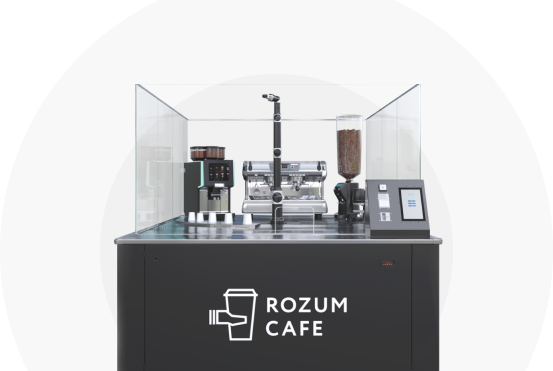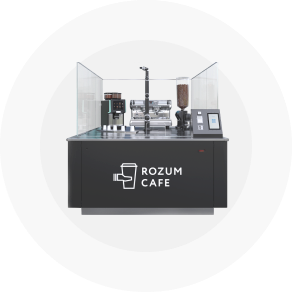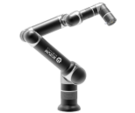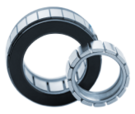What is a servo drive? A servo drive is typically coupled to a servomechanism as a stand-alone module. It orchestrates exchange of control and feedback signals, while boosting performance of the mechanism.
The device leverages the algorithm as detailed below:
The module receives a low-voltage command signal. Amplifying the input (that’s why it is often referred to as the amplifier), it generates such amounts of Volts and Amperes as required to produce motion. The drive applies the resulting voltage and current to the servo to make it move to a particular angle with specific speed and acceleration, while producing desired torque. Based on the reaction from an error-sensing device (e.g., encoder, resolver), the drive determines whether target parameters are achieved and compensates any deviations.
Benefits
An amplifier provides the following major benefits, when integrated with a servomechanism:
Communicating with feedback devices, it collects motion-related statistics. The more varied the data is, the more precise speed regulation and the better positioning accuracy a drive module can ensure.
Power density is defined as the amount of watts generated per unit of volume. Maximizing the rating allows to pack more power in small size to free space for integrating additional equipment, such as electronics to enhance precision.
Higher power density entails lower cable losses due to resistance because system elements are relocated closer towards the load. Lighter weight and trimmed dimensions ensure portability, while facilitating installation and maintenance, which minimizes cost of ownership.
- Improved position settling time
For a servo drive, settling time is the interval needed to reach and maintain a value range close to the commanded one. A parameter of critical effect on the settling rate is damping ratio. The value impacts the way an engine acts to achieve specific motion characteristics and reacts to follow-up corrections.
Technical note:
It is possible to distinguish three types of servo applications—over-damped, under-damped, and critically damped. In an over-dampedsystem, it takes quite a while to approach a commanded level, which allows to do away with overshoots and diminish settling time. An under-damped system provides a faster response to commands. However, overshoots are more probable. Oscillation, also known as ringing, is significant, at least until a servo reaches preset values. A critically damped servomechanism is a compromise between the above two. With only slight overshoots, it boasts minimized ringing and short settling time.
Reduced speed ripple
Speed (velocity) ripple meas variation of steady-state velocity over time. It can occur as a result of torque ripple, which can be due to factors, such as cogging, mechanical imbalance, rotor eccentricity, etc.
The phenomenon deteriorates servomechanism performance, especially at low rotation rates. Ripple suppression makes it possible to smooth starts and stops, as well as transient movements.
DC vs. AC
A DC amplifier transforms alternating current (AC) input into direct one (DC), using thyristors—silicon-controlled rectifiers (SCR). The process relies either the half-bridge or the full-bridge method. In the first case, a DC module employs a few thyristors to convert single-phase AC input into DC output. The full-bridge method is when each phase of the AC input utilizes two SCRs.
Technical note:
A SCR is a semiconductor that lets current pass in only one direction. By its operation principle, it is similar to a diode. However, unlike a diode, it has a third element—a gate that switches thyristor on when a voltage pulse is applied. A SCR remains in the “on” state, provided it is forward-biased and the applied voltage signal is of proper polarity. To switch it off, it is essential to reverse voltage.
An AC servo drive is fed with alternating current, which is subsequently rectified to the direct type as it flows through a SCR or a bridge rectifier. Additionally, an AC amplifier contains a capacitor bank that stabilizes and smoothes out the DC output. Then, transistors or IGBT modules convert the DC output back to AC, transferring the flow to the servo. The double conversion allows to increase the output amperage dozen- or even hundred folds without inflicting any damage on the motor coils. The feature also enables rapid speed switching.
Apart from the obvious—the type of power supply, it is essential to count in other criteria when choosing between an AC servo amplifier and a DC one. The table below lists the most common selection principles.
AC:
A perfect fit for those systems that require braking or reversing.
- Installation and operation
Demand certain amount of commissioning efforts—i.e.,configuration of parameters; lately, substantial progress has been made in this respect by introducing default and quick-start settings.
- Availability and affordability
For a more high-powered engine, AC models are cheaper.
Requirements to education and experience of service specialists are higher.
DC:
A usual choice when an application has high starting torque, such as occurring when pumping viscous substances, handling centrifugal loads.
- Installation and operation
Commissioning is as simple as connecting four wires and flipping the switch. The setup process comes down to a few trim pot adjustments.
- Availability and affordability
The more power a motor gives, the higher the cost of a DC drive is.
DC modules are easier to service due to their unsophisticated design.
Control modes
Whether DC or AC, a servo drive has the same operation principle. It compares reference values contained in commands to those returned as feedback. The difference between the reference and the response is error. To correct the error, the drive applies gain.
An amplifier supports the following control modes:
PositionVelocityTorque.
The torque mode is the most common one: the device orchestrates amperage supply to a servo to adjust the torque rate. The value varies in accordance with the formula: turning force is current multiplied by the engine-specific torque constant.
The position mode is when the module commands a servo to move to a predefined position with certain velocity. In other words, you can adjust two parameters—the target distance (angle) to travel and the motion speed. The mode is advisable in applications where exceptional accuracy is mandatory.
In the speed mode, velocity is regulated by switching voltage within the range of 0–10 V by means of an external pot. Typical of analog mechanisms, the mode is intended to accelerate the servomechanism to a desired velocity and then keep it at around that value.
RDrive integrates servo drive functions
RDrive servos do not require stand-alone drives because the functionality of the modules is fully implemented in the proprietary controllers built into their housings.
RDrive controllers generate command current, causing motors to move, and communicate with the output shaft and rotor shaft encoders, reading angular positions. Finally, they compare the feedback from encoders with command signals, e.g., from a PC, and fine-tune the resulting motion to match the desired settings.
Based on the feedback, controllers also calculate motion parameters, such as velocity and torque. Simultaneously, they collect data about voltage, temperature, as well as other measurements to give you a comprehensive picture of servo operation.
Thanks to the control loop packed into the same body with a power core, RDrive engines are ultra-compact all-in-one motion solutions. Buying an RDrive actuator, you have to worry neither about a place to locate an amplifier or arrangements to integrate it. Instead, you can create and execute trajectories by communicating directly with individual controllers integrated into servo housings. Communication options include a CANOpen protocol stack and the purpose-built Application Programming Interface (API) in Python and Java with an underlying C library.














